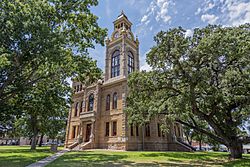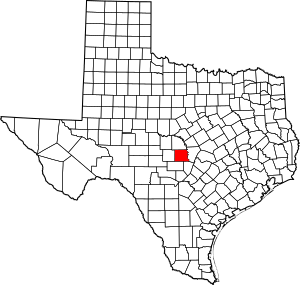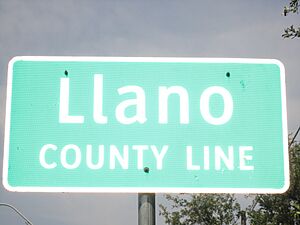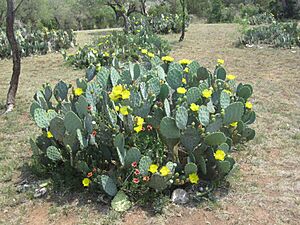Llano County, Texas facts for kids
Quick facts for kids
Llano County
|
|
|---|---|

The Llano County Courthouse in Llano
|
|

Location within the U.S. state of Texas
|
|
 Texas's location within the U.S. |
|
| Country | |
| State | |
| Founded | 1856 |
| Named for | Llano River |
| Seat | Llano |
| Largest city | Horseshoe Bay |
| Area | |
| • Total | 966 sq mi (2,500 km2) |
| • Land | 934 sq mi (2,420 km2) |
| • Water | 32 sq mi (80 km2) 3.3% |
| Population
(2020)
|
|
| • Total | 21,243 |
| • Density | 21.991/sq mi (8.491/km2) |
| Time zone | UTC−6 (Central) |
| • Summer (DST) | UTC−5 (CDT) |
| Congressional district | 11th |
Llano County is a county located in the Edwards Plateau area of Texas. In 2020, about 21,243 people lived there. The main town and county seat is Llano. The county gets its name from the Llano River that flows through it.
Contents
A Look at Llano County's Past
Llano County has a rich history, starting with its first inhabitants and growing over time.
Early Days and Settlements
- The Tonkawa tribe were the first people to live in this area.
- In 1842, a large piece of land called the Fisher-Miller Land Grant was set aside. It was meant to help 600 families from Germany, the Netherlands, Switzerland, Denmark, Sweden, and Norway settle in Texas.
- The Adelsverein was a group that helped these European families move to Texas.
- In 1847, the Meusebach–Comanche Treaty was signed. This important agreement helped create peace between the German settlers and the Comanche people.
- One of the last communities started by the Adelsverein was Bettina, founded by a group of thinkers. However, it did not last long because it lacked a clear leader.
Growth and Challenges
- By 1860, Llano County had 1,101 people.
- During the American Civil War, about 100 volunteers from Llano County joined the Confederate States Army.
- In 1864, a special cavalry company was formed in Llano County. Their job was to protect the area from Native American attacks.
- The last battle with Native Americans in the region happened in 1873 at Packsaddle Mountain. After this, farming in the county began to grow safely.
- The Austin and Northwestern Railroad reached Llano in 1892, helping the county connect with other places.
- The beautiful Llano County Courthouse was finished in 1893. The Llano County Jail was built in 1895.
- In 1901, the historic Antlers Hotel opened in Kingsland. It was a popular resort for people traveling by train.
The Darmstadt Society of Forty
The Adelsverein group also worked with another group called the Darmstadt Society of Forty. This group planned to bring 200 families to the Fisher–Miller Land Grant. They were given money, animals, and supplies to help them start their new lives.
Several communities were attempted, including Castell, Leiningen, and Bettina. However, most of these settlements did not last. This was because the funding ran out, and there were disagreements about how to run the communities. Today, only Castell still exists.
Library Books and Community Decisions
In 2021 and 2022, some books were removed from Llano County libraries. This decision was made by county leaders. A librarian named Suzette Baker was fired because she did not want to remove books.
Later, a lawsuit was filed. In March 2023, a federal judge ordered that at least 12 of the books must be put back on the shelves. County leaders then thought about closing the library. They have appealed the judge's decision.
Exploring Llano County's Geography
Llano County covers a total area of 966 square miles. Most of this is land (934 square miles), and 32 square miles (about 3.3%) are covered by water.
Natural Wonders
Enchanted Rock is a famous natural area and a popular place for tourists. It is located in the southern part of Llano County.
Two important rivers, the Llano River and the Colorado River, flow through the county. These rivers help form several lakes, including Lake Buchanan, Inks Lake, and Lake Lyndon B. Johnson. Parts of these lakes are found within Llano County.
Main Roads in Llano County
Neighboring Counties
Llano County shares borders with these other counties:
- San Saba County (to the north)
- Burnet County (to the east)
- Blanco County (to the southeast)
- Gillespie County (to the south)
- Mason County (to the west)
Who Lives in Llano County?
Here's a look at how the population of Llano County has changed over the years.
| Historical population | |||
|---|---|---|---|
| Census | Pop. | %± | |
| 1860 | 1,101 | — | |
| 1870 | 1,379 | 25.2% | |
| 1880 | 4,962 | 259.8% | |
| 1890 | 6,772 | 36.5% | |
| 1900 | 7,301 | 7.8% | |
| 1910 | 6,520 | −10.7% | |
| 1920 | 5,360 | −17.8% | |
| 1930 | 5,538 | 3.3% | |
| 1940 | 5,996 | 8.3% | |
| 1950 | 5,377 | −10.3% | |
| 1960 | 5,240 | −2.5% | |
| 1970 | 6,979 | 33.2% | |
| 1980 | 10,144 | 45.4% | |
| 1990 | 11,631 | 14.7% | |
| 2000 | 17,044 | 46.5% | |
| 2010 | 19,301 | 13.2% | |
| 2020 | 21,243 | 10.1% | |
| U.S. Decennial Census | |||
Population Makeup
The table below shows the different racial and ethnic groups living in Llano County. The US Census counts Hispanic/Latino people as an ethnic group, and they can be of any race.
| Race / Ethnicity (NH = Non-Hispanic) | Pop 2000 | Pop 2010 | Pop 2020 | % 2000 | % 2010 | % 2020 |
|---|---|---|---|---|---|---|
| White alone (NH) | 15,869 | 17,303 | 17,530 | 93.11% | 89.65% | 82.52% |
| Black or African American alone (NH) | 51 | 102 | 97 | 0.30% | 0.53% | 0.46% |
| Native American or Alaska Native alone (NH) | 58 | 87 | 115 | 0.34% | 0.45% | 0.54% |
| Asian alone (NH) | 59 | 76 | 121 | 0.35% | 0.39% | 0.57% |
| Pacific Islander alone (NH) | 5 | 5 | 4 | 0.03% | 0.03% | 0.02% |
| Other Race alone (NH) | 8 | 11 | 61 | 0.05% | 0.06% | 0.29% |
| Mixed Race or Multiracial (NH) | 119 | 175 | 807 | 0.70% | 0.91% | 3.80% |
| Hispanic or Latino (any race) | 875 | 1,542 | 2,508 | 5.13% | 7.99% | 11.81% |
| Total | 17,044 | 19,301 | 21,243 | 100.00% | 100.00% | 100.00% |
In 2000, there were 17,044 people living in Llano County. The average age was 53 years old. The median income for a household was about $34,830. About 10.3% of the population lived below the poverty line.
Towns and Villages in Llano County
Here are the different types of communities you can find in Llano County:
Cities
- Horseshoe Bay (partly in Burnet County)
- Llano (county seat)
- Sunrise Beach Village
Census-designated places
These are areas that are like towns but are not officially incorporated as cities.
Other unincorporated communities
These are smaller communities that are not officially part of a city or town.
Ghost towns
These are places where people used to live, but now they are mostly empty.
Notable People from Llano County
- Emil Kriewitz lived with the Penateka Comanche tribe. He helped settlers find their way in the Fisher–Miller Land Grant area. He also served as a justice of the peace and election judge in Llano County. He was the postmaster of Castell for several years.
See also
 In Spanish: Condado de Llano para niños
In Spanish: Condado de Llano para niños



